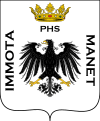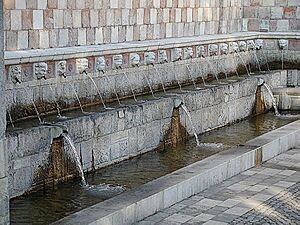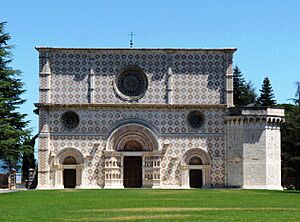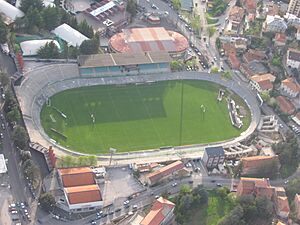L'Aquila facts for kids
Quick facts for kids
L'Aquila
|
|||
|---|---|---|---|
| Comune dell'Aquila | |||
|
|||
| Country | Italy | ||
| Region | Abruzzo | ||
| Province | L'Aquila | ||
| Frazioni | see list | ||
| Area | |||
| • Total | 473.91 km2 (182.98 sq mi) | ||
| Elevation | 714 m (2,343 ft) | ||
| Population
(31 December 2013)
|
|||
| • Total | 70,967 | ||
| • Density | 149.7478/km2 (387.845/sq mi) | ||
| Demonym(s) | Aquilani | ||
| Time zone | UTC+1 (CET) | ||
| • Summer (DST) | UTC+2 (CEST) | ||
| Postal code |
67100
|
||
| Dialing code | 0862 | ||
| Patron saint | St. Maximus, St. Equitius, St. Peter Celestine, St. Bernardino of Siena | ||
| Saint day | June 10 | ||
L'Aquila is a city in central Italy. It is the capital of the Abruzzo region and the Province of L'Aquila. In 2024, about 69,902 people lived there. The city is built on a hill in the wide valley of the Aterno River. It is surrounded by the Apennine Mountains, with the Gran Sasso d'Italia to the northeast.
L'Aquila has many narrow streets and old buildings. You can see Baroque and Renaissance styles. The city is home to the University of L'Aquila. This makes it a lively college town. It has cultural places like a theater and a symphony orchestra. There are also several ski resorts nearby. These include Campo Imperatore and Roccaraso.
Contents
Geography of L'Aquila
L'Aquila is high up in the Apennine Mountains. It sits at about 721 meters (2,365 feet) above sea level. The city is in the Valley of the Aterno-Pescara River. It is surrounded by four mountain peaks. Some of these peaks are over 2,000 meters (6,560 feet) tall.
Climate in L'Aquila
The tall mountains block warm, moist air from the Mediterranean Sea. This gives L'Aquila a cool and dry climate. Locals often say it has "eleven cold months and one cool one." This means it's chilly most of the year.
Location and Connections
L'Aquila is about 100 kilometers (62 miles) east-northeast of Rome. An expressway connects the two cities. This road goes through the mountains.
History of L'Aquila
L'Aquila's history is full of important events. It grew from many small villages.
Early History and Founding
The city's building started in the 13th century. Frederick II, Holy Roman Emperor, and King of Sicily, began its construction. It was meant to be a strong point against the Pope's power. Local stories say it was built from 99 villages. The name "Aquila" means "Eagle" in Italian.
Construction finished in 1254. This was under Frederick's son, Conrad IV of Germany. The city was destroyed in 1259 by Conrad's brother, Manfred. But it was quickly rebuilt by Charles I of Anjou. The city walls were finished in 1316.
Growth and Importance
L'Aquila quickly became the second most important city in the Kingdom of Naples. It was a self-governing city. It had a City Council and a King's Captain. The city's power came from its connection to the villages that founded it. Each village built a part of the city.
The famous Fountain of the 99 Spouts (Fontana delle 99 Cannelle) celebrates this origin. It has 99 water jets.
L'Aquila became an important market. It traded saffron from its valleys. Sheep from the mountains provided wool. This brought many traders and craftspeople to the city. It was a key stop on the "via degli Abruzzi." This road connected cities like Florence and Naples.
Important Events and People
In 1294, the hermit Pietro del Morrone became Pope Celestine V. He was crowned in the church of Santa Maria di Collemaggio. To remember this, he started the "Pardon" (now called Celestinian Forgiveness). This religious event still happens every year on August 28 and 29. It was the first "Jubilee Year" event.
The city also faced challenges. In the 14th century, it had plague and earthquakes. But it was rebuilt. In the 15th century, Bernardino of Siena, a famous Franciscan friar, visited L'Aquila. He died there in 1444. A large church, the Basilica of San Bernardino, was built in his honor.
L'Aquila was involved in many political choices. It sometimes sided with the Pope, sometimes with the Kingdom of Naples. In 1424, the city was under a long siege by a military leader named Braccio da Montone. L'Aquila bravely resisted. Braccio was defeated and died in L'Aquila. The citizens honored his bravery by naming a street after him.
Modern Challenges
The city's freedom ended in the 16th century. Spanish rulers partly destroyed L'Aquila. They also set up a feudal system in the countryside. The city lost its old privileges.
L'Aquila was badly damaged by a major earthquake in 1703. Over 3,000 people died. Most churches collapsed. The city was rebuilt again. It was also attacked by French troops twice in 1799.
In 2003, there was a legal case about a crucifix in a school. A judge ordered it removed, but this decision was later changed after many people protested. In 2007, Massimo Cialente became mayor. He was part of a center-left group.
Earthquakes in L'Aquila
Earthquakes have shaped L'Aquila's history. The city is partly built on an old lake-bed. This makes earthquake shaking worse.
Past Earthquakes
- In 1315, an earthquake damaged the San Francesco Church.
- In 1349, another earthquake killed about 800 people.
- More earthquakes happened in 1452, 1461, 1501, and 1646.
- The 1703 earthquake was very strong. It destroyed many buildings.
- In 1706, another earthquake hit the area.
- A 5.0 magnitude earthquake struck in 1958.
The 2009 L'Aquila Earthquake

On April 6, 2009, a 6.3 magnitude earthquake struck central Italy. Its center was near L'Aquila. The earthquake damaged thousands of buildings. Many buildings collapsed.
- 308 people died.
- About 1,500 people were hurt.
- 20 of the victims were children.
- Around 65,000 people lost their homes.
- Many students were trapped in a damaged dormitory.
The earthquake was felt in many parts of Italy.
G8 Summit in L'Aquila
Because of the 2009 earthquake, the Berlusconi government decided to move the G8 summit to L'Aquila. This was to help the affected region. It also showed support for the city's people. World leaders met in L'Aquila on July 8, 2009. Many leaders toured the damaged city.
Main Sights in L'Aquila
L'Aquila is not visited by many tourists. But it has many interesting places to see. Romans often visit for hiking and skiing.
Religious Buildings
- L'Aquila Cathedral: This main church was built in the 13th century. It was destroyed by the 1703 earthquake. The front of the church was rebuilt in the 19th century. The 2009 earthquake damaged parts of it again.
- Basilica of San Bernardino (1472): This church has a beautiful Renaissance front. It holds the tomb of Saint Bernardino.
- Santa Maria di Collemaggio: This church is just outside the town. It has a simple but beautiful Romanesque front. It is made of red and white marble. It also holds the tomb of Pope Celestine V.
- Santa Giusta: A Romanesque church with a Gothic rose window.
- San Silvestro: A 14th-century church with a Romanesque front and Gothic rose window.
Secular Buildings and Landmarks
- Spanish Fort (Forte Spagnolo) : This is a huge castle. It was built in 1534 by the Spanish ruler Don Pedro de Toledo. Today, it is home to the National Museum of Abruzzo.
- Fontana Luminosa ("Luminous Fountain"): A sculpture from the 1930s. It shows two women holding large jars.
- Fontana delle novantanove cannelle (1272): This is the Fountain of the 99 Spouts. It has 99 water jets along three walls. No one knows where the water comes from.
- Palace of Nobles: An important historic building.
- Roman ruins of Amiternum: These are the remains of an ancient Roman city.
There are also several ski resorts nearby. These include Gran Sasso d'Italia. The movie The Name of the Rose was filmed in its valley. The city also has old palaces with art collections.
Culture in L'Aquila
L'Aquila has a rich cultural life.
Film and Theater
The city has a history with movies. The l'Istituto Cinematografico dell'Aquila was founded in 1981. It helps produce and share film culture. The Teatro Stabile d'Abruzzo is a theater company based in the city. It started in 2000.
Sports in L'Aquila
The city is home to L'Aquila Rugby. This rugby team has won the Italian championship five times. The football team, L'Aquila Calcio, has played three times in Italy's Serie B league.
Villages (Frazioni) of L'Aquila
L'Aquila is made up of many smaller villages called frazioni. Here are some of them: Aquilio, Aragno, Arischia, Assergi, Bagno, Bazzano, Camarda, Cansatessa, Casaline, Cermone, Cese di Preturo, Civita di Bagno, Colle di Preturo, Colle di Sassa, Colle Roio – Poggio di Roio, Collebrincioni, Collefracido di Sassa, Coppito, Filetto, Foce di Sassa, Forcelle, Genzano di Sassa, Gignano, Monticchio, Onna, Paganica, Pagliare di Sassa, Pescomaggiore, Pettino, Pianola, Pile, Pizzutillo, Poggio di Roio, Poggio Santa Maria, Pozza di Preturo, Pratelle, Preturo, Ripa, Roio Piano, San Giacomo Alto, San Giuliano, San Gregorio, San Leonardo, San Marco Di Preturo, San Martino di Sassa, Santa Rufina di Roio, Sant'Angelo, Sant'Elia, Santi, San Vittorino, Sassa, Tempera, Torretta, Vallesindola, Vasche.
International Connections
L'Aquila is twinned with several cities around the world. This means they have special friendly relationships.
 Baalbek, Lebanon
Baalbek, Lebanon Bernalda, Italy
Bernalda, Italy Bistrița, Romania
Bistrița, Romania Cuenca, Spain
Cuenca, Spain Foggia, Italy
Foggia, Italy Haining, China
Haining, China Hobart, Australia
Hobart, Australia Rottweil, Germany
Rottweil, Germany San Carlos de Bariloche, Argentina
San Carlos de Bariloche, Argentina Sant'Angelo d'Alife, Italy
Sant'Angelo d'Alife, Italy Siena, Italy
Siena, Italy Washington, United States
Washington, United States York, Toronto, Canada
York, Toronto, Canada Zielona Góra, Poland
Zielona Góra, Poland
Transport in L'Aquila
L'Aquila railway station is the city's main train station. It is on the Terni–Sulmona railway line. You can take trains to Terni, Rieti, and Sulmona.
Notable People from L'Aquila
Many famous people have connections to L'Aquila.
- Mariangelo Accorso (1489–1546), a scholar.
- Amico Agnifili (1398–1476), a Cardinal.
- Antonia of Florence (1402–1472), a saint.
- Corrado Bafile (1903–2005), a Cardinal.
- Bernardino da Siena (1380–1444), a saint.
- Braccio da Montone (1368–1424), a military leader.
- Giovanbattista Branconio dell'Aquila (1473–1522), a papal official and friend of Raphael.
- Buccio di Ranallo (1294–1363), a poet and historian.
- Raffaele Cappelli (1848–1921).
- John of Capistrano (1386–1456), a saint.
- Celestine V (1215–1296), a saint and Pope.
- Pompeo Cesura (d. 1571), a painter.
- Appius Claudius Caecus (350 BC–271 BC), an ancient Roman politician.
- Marco Dall'Aquila (c.1480-after 1538), a musician.
- Nazzareno De Angelis (1881–1962), an opera singer.
- Nicola Di Francia (born 1985), a footballer.
- Carlo Franchi (1938–2021), a racing driver.
- Nestore Leoni (1862–1947), a painter.
- Mario Magnotta (1942–2009), a janitor who became an internet phenomenon.
- Lorenzo Natali (1922–1989), a vice-president of the European Commission.
- Paul Piccone (1940–2004), a writer.
- Roberto Ruscitti (b. 1941), a composer.
- Sallustius (4th century), a historian.
- Karl Heinrich Ulrichs (1825–1895), a writer who lived in L'Aquila.
- Trebisonda Valla (1916–2006), an Olympic gold medalist.
- Amleto Vespa (1888–1940), a spy.
- Bruno Vespa (b. 1944), a journalist.
- Claudia Romani (b. 1982), a model.
- Ferdinando Bologna (1925–2019), an art historian.
Images for kids
See also
 In Spanish: L'Aquila para niños
In Spanish: L'Aquila para niños











